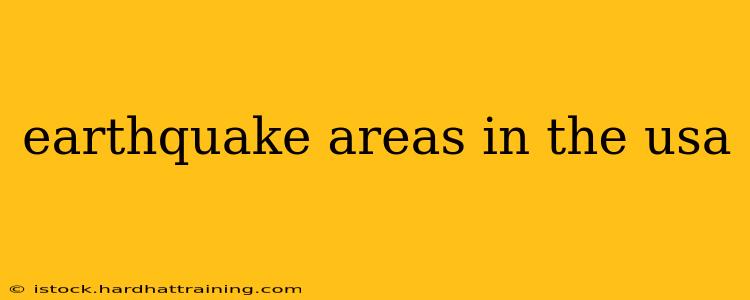The United States, despite its vast size and diverse geography, is not immune to the devastating power of earthquakes. While some areas experience frequent tremors, others face the threat of infrequent but potentially catastrophic events. Understanding these seismic zones is crucial for preparedness and mitigation efforts. This comprehensive guide will explore the earthquake-prone areas of the USA, highlighting the underlying geological reasons and the associated risks.
Major Seismic Zones in the United States
The United States Geological Survey (USGS) divides the country into several seismic zones based on historical earthquake activity and geological features. These zones are not static; the risk level can vary within a single zone.
1. The West Coast: The Ring of Fire
The most seismically active region is undoubtedly the West Coast, situated along the infamous Ring of Fire. This area encompasses:
-
California: California is the most earthquake-prone state, with the San Andreas Fault being the most well-known. This fault system is responsible for major earthquakes throughout California's history, including the devastating 1906 San Francisco earthquake. Other significant fault lines crisscross the state, leading to frequent smaller earthquakes and the ever-present risk of larger ones. Areas like Los Angeles, San Francisco, and San Diego are particularly vulnerable.
-
Oregon and Washington: These states also lie within the Ring of Fire and experience significant seismic activity, although generally less frequent than in California. The Cascadia Subduction Zone, a megathrust fault capable of producing massive earthquakes and tsunamis, poses a substantial threat to the Pacific Northwest.
-
Alaska: Alaska, due to its location on a convergent plate boundary, experiences some of the strongest earthquakes in the United States. The Aleutian Islands are particularly active.
2. The Central and Eastern United States: Less Frequent, But Still Significant
While the West Coast dominates the earthquake landscape, the central and eastern parts of the country are not entirely exempt. Seismic activity here is less frequent and generally of lower magnitude, but significant historical earthquakes highlight the potential for damage.
-
New Madrid Seismic Zone: Located in the central Mississippi River Valley, this zone experienced a series of devastating earthquakes in 1811-1812. While these events were centuries ago, the area remains seismically active, and future earthquakes of significant magnitude are possible. States like Missouri, Arkansas, Tennessee, Kentucky, and Illinois are within this zone.
-
Intermountain Seismic Belt: This region spans several states, including Utah, Idaho, Montana, and Wyoming. The area’s complex geology makes it susceptible to earthquakes.
-
Eastern Tennessee and Western North Carolina: This area, though less prone to frequent events than the West Coast, has experienced historically significant earthquakes and remains subject to future tremors.
3. Understanding Seismic Hazard Maps
The USGS provides detailed seismic hazard maps that show the probability of ground shaking at various locations across the country. These maps are invaluable tools for assessing risk, informing building codes, and guiding land-use planning. Consulting these maps is essential for anyone living in or developing property in a potentially earthquake-prone region.
Preparing for Earthquakes: A Crucial Step
Regardless of location, preparation is paramount. Understanding your risk level and implementing safety measures, including earthquake drills, securing heavy objects, and having an emergency kit, can significantly reduce the impact of an earthquake. Staying informed about earthquake preparedness through resources like the USGS and local emergency management agencies is also vital.
This information provides a general overview. For the most detailed and up-to-date information on earthquake risk in specific areas, consult the USGS website. Knowledge is power, and understanding the earthquake potential in your region is the first step towards safety and resilience.
